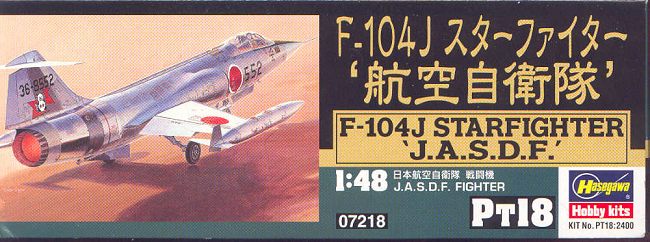
|
KIT: |
Hasegawa 1/48 F-104J Starfighter |
|
KIT # |
PT 18 |
|
PRICE: |
¥2400 |
|
DECALS: |
See review |
|
REVIEW & |
|
|
NOTES: |
|

|
HISTORY |
The Lockheed F-104 Starfighter was first conceived in the early 1950s in response to a U.S. Air Force (USAF) requirement for high-performance fighter with supersonic capability in level flight. In response, noted Lockheed designer Kelly Johnson produced an aircraft of radical design that immediately produced some noteworthy advances in fighter design. The F-104 was the first production combat aircraft capable of sustained Mach 2 speed in level flight; the type also introduced the first inertial-navigation equipment fitted to a fighter.
The F-104A first entered service with the USAF in 1958 as part of Aerospace Defense Command. High attrition rates, lack of all-weather capability, and its inability to operate within the SAGE air defense system prompted the USAF to withdraw the F-104A from ADC service; surviving airframes were transferred to the Air National Guard, where they served until 1968. Deliveries of improved F-104Cs began in 1962, and one ANG squadron, in Puerto Rico, operated the F-104C until 1975.
The fighter that the USAF essentially rejected became the choice of many
allied nations. The Republic of China was the first export customer in
1958; 15 other nations followed with substantial F-104 orders. The
Starfighter was produced under license in Japan, Germany, Belgium, and Italy,
and formed the backbone of NATO's tactical air arm for nearly two
decades. Even today, F-104s continue in front-line service with
Italy and the Republic of China; the latter's continuous use of the F-104 for
over 42 years is a record that may not be broken anytime soon. (Editor's
Note: Taiwan has only recently retired its F-104s in the last few months. Italy
will be using them until the Eurofighter comes on line.)
|
THE KIT |
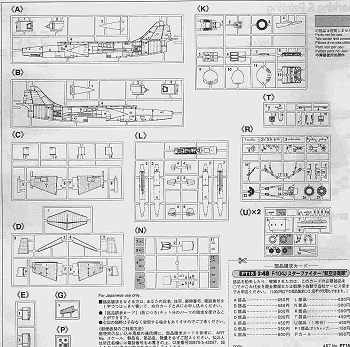 Hasegawa has an
illustrious history of producing excellent F-104 kits. In the 1970s they
released a fine 1/32nd scale version, and more recently they did a series of
1/72nd scale F-104s. The 1/72nd kits were incredible productions,
with fully detailed cockpits, a full complement of clear lights, comprehensive
landing gear detail, and stellar component fit. With that pedigree, the
announcement of a new-tool 1/48th Starfighter kit for 2000 generated quite a bit
of excitement. Up to now the only real choice in 1/48th scale was
the now out of production Monogram kit, which, while good, nonetheless had the
1970s Monogram hallmarks of raised detail and problematic fit.
Hasegawa has an
illustrious history of producing excellent F-104 kits. In the 1970s they
released a fine 1/32nd scale version, and more recently they did a series of
1/72nd scale F-104s. The 1/72nd kits were incredible productions,
with fully detailed cockpits, a full complement of clear lights, comprehensive
landing gear detail, and stellar component fit. With that pedigree, the
announcement of a new-tool 1/48th Starfighter kit for 2000 generated quite a bit
of excitement. Up to now the only real choice in 1/48th scale was
the now out of production Monogram kit, which, while good, nonetheless had the
1970s Monogram hallmarks of raised detail and problematic fit.
Upon opening the box, one is greeted with a single sprue bag containing the clear parts, and a second bag containing everything else. On my sample there were fine scratches on many of the external surfaces; I wish Hasegawa would separately bag sprues, especially on aircraft to be finished in natural metal. After that initial off-putting experience, things started to look a lot better.
The kit is set up as a Japanese-built F-104J, with a Lockheed C2 upward firing ejection seat, narrow main gear wheels with nonbulged doors, and a JASDF external stores fit of tip tanks and underfuselage Sidewinder rails. No other underwing stores are included, but there are holes in the wings that can be cut out to fit pylons, indicating other versions are forthcoming. All control surfaces, including flaps and slats, are separate and positionable.
Surface detail is primarily recessed, including subtly recessed flush rivets. Where appropriate, there are raised panels. The louver detail around the nose gear bay/underfuselage is stunning, but it is close to join lines, so very good gluing technique will be needed here.
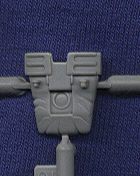 The Lockheed C-2 seat for
the cockpit is built from no less than 13 parts, including separate oxygen
hoses! Instrument panel and side console panel details are typically
sharp. An interesting feature is that two control sticks are given, both
exactly the same--maybe a TF-104 is forthcoming? There is sidewall detail
in the fuselage halves and a beautifully done instrument panel coaming (see
image to left).
The Lockheed C-2 seat for
the cockpit is built from no less than 13 parts, including separate oxygen
hoses! Instrument panel and side console panel details are typically
sharp. An interesting feature is that two control sticks are given, both
exactly the same--maybe a TF-104 is forthcoming? There is sidewall detail
in the fuselage halves and a beautifully done instrument panel coaming (see
image to left).
Other than new seat harnesses to replace the molded-on harnesses (grrr....) very little will be needed to make this cockpit come alive.
Landing gear is excellent. Wheel wells are nicely detailed. Two different hubs are provided for the main gear tires: spoked and non-spoked, and the hubs are molded totally separately from the tires; no such luck on the nose wheel, but at least the rim of the hub is prominent so painting will be easy. All gear doors are well detailed inside, even though the large main gear doors are nearly closed on the ground.
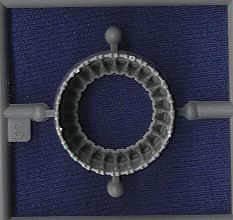 The intake trunks have
nice renditions of the shock cones used inside the intakes. The intake
lips themselves are very sharp. Unfortunately full intake trunking is not
included, but the intakes go deep enough that only the penlight wielders will
catch this! On the other hand, full exhaust trunking is given, and it
includes a separate flameholder. The afterburner leaves themselves are
exquisite, as seen here to the right:
The intake trunks have
nice renditions of the shock cones used inside the intakes. The intake
lips themselves are very sharp. Unfortunately full intake trunking is not
included, but the intakes go deep enough that only the penlight wielders will
catch this! On the other hand, full exhaust trunking is given, and it
includes a separate flameholder. The afterburner leaves themselves are
exquisite, as seen here to the right:
The clear parts are classic Hasegawa: clear, thin, and distortion free. The canopy can be posed open if desired. The clear parts also include all of the fuselage and wing tip tank lights seen on the F-104, however, the appropriate holes in the fuselage will need to be drilled out to accept them. You'll need to drill out the holes in the fuselage for the lights BEFORE assembly; the Hasegawa instructions indicate that this should be done during final assembly. I'm not sure I like this feature, but it might make life easier for the less advanced modeler not wanting to deal with a lot of tiny clear parts.
I haven't fitted anything together yet, so I can't comment there.
Hopefully all these pieces will come together easily, espcially for the natural
metal builders. If recent kits are any indication, we have nothing to
worry about!
|
DECALS |
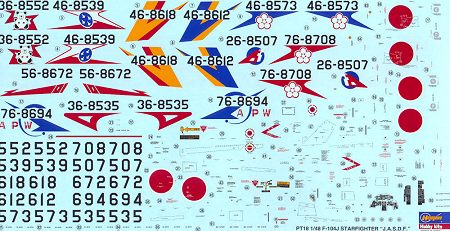
Decals are strictly for Japanese F-104Js of all squadrons, either in overall natural metal or gray with natural metal hot sections. A number of JASDF F-104Js recieved special liveries at one time or another, so careful research can yield some different and much more interesting schemes! One that can be done right from the box is an aggressor aircraft from 203 Squadron, as I did on an ESCI F-104 kit some years ago, see the review on this site for a look at this scheme.
The decal is on typical Hasegawa decal stock, but is sharply printed and
includes many stencils. By cutting and swapping numbers any Starfighter as
used by the JASDF can be built from the sheet.
|
CONCLUSIONS |
I think it can be concluded that Hasegawa loves the F-104! Every kit they have produced has been a tour de force for its time, and this new 1/48th scale kit is no exception. It will be interesting to see how FreMs does with their forthcoming F-104S; they now have a very tough act to follow.
This kit is undoubtedly the first of a flood of F-104s from Hasegawa, as there are many points where other sprues are gated off. The NATO builders will have a lot to look forward to in the coming years!
|
REFERENCES |
John Fricker, "Lockheed F-104 Starfighter": Wings of Fame, Volume 2, Aerospace Publishing, 1996
Personal photo collection
If you would like your product reviewed fairly and quickly by a site that has over 900 visits a day, please contact me or see other details in the Note to Contributors.